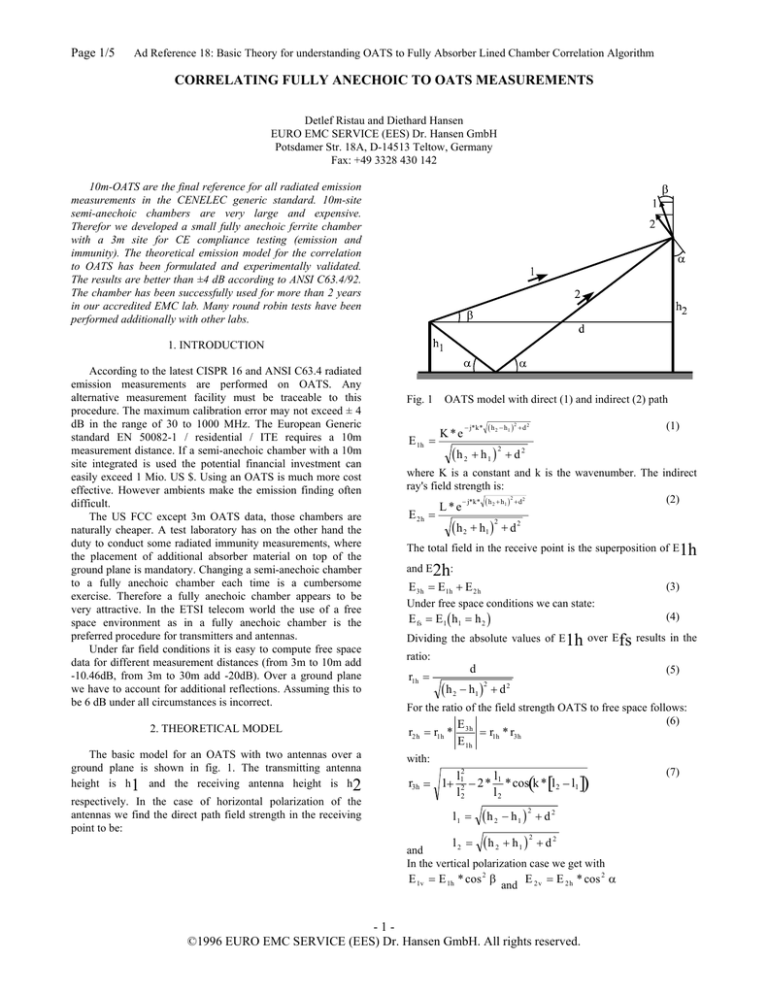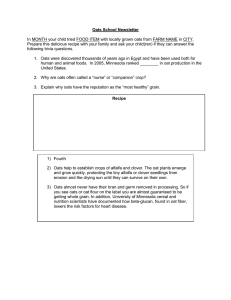
Page 1/5
Ad Reference 18: Basic Theory for understanding OATS to Fully Absorber Lined Chamber Correlation Algorithm
CORRELATING FULLY ANECHOIC TO OATS MEASUREMENTS
Detlef Ristau and Diethard Hansen
EURO EMC SERVICE (EES) Dr. Hansen GmbH
Potsdamer Str. 18A, D-14513 Teltow, Germany
Fax: +49 3328 430 142
10m-OATS are the final reference for all radiated emission
measurements in the CENELEC generic standard. 10m-site
semi-anechoic chambers are very large and expensive.
Therefor we developed a small fully anechoic ferrite chamber
with a 3m site for CE compliance testing (emission and
immunity). The theoretical emission model for the correlation
to OATS has been formulated and experimentally validated.
The results are better than ±4 dB according to ANSI C63.4/92.
The chamber has been successfully used for more than 2 years
in our accredited EMC lab. Many round robin tests have been
performed additionally with other labs.
1. INTRODUCTION
According to the latest CISPR 16 and ANSI C63.4 radiated
emission measurements are performed on OATS. Any
alternative measurement facility must be traceable to this
procedure. The maximum calibration error may not exceed ± 4
dB in the range of 30 to 1000 MHz. The European Generic
standard EN 50082-1 / residential / ITE requires a 10m
measurement distance. If a semi-anechoic chamber with a 10m
site integrated is used the potential financial investment can
easily exceed 1 Mio. US $. Using an OATS is much more cost
effective. However ambients make the emission finding often
difficult.
The US FCC except 3m OATS data, those chambers are
naturally cheaper. A test laboratory has on the other hand the
duty to conduct some radiated immunity measurements, where
the placement of additional absorber material on top of the
ground plane is mandatory. Changing a semi-anechoic chamber
to a fully anechoic chamber each time is a cumbersome
exercise. Therefore a fully anechoic chamber appears to be
very attractive. In the ETSI telecom world the use of a free
space environment as in a fully anechoic chamber is the
preferred procedure for transmitters and antennas.
Under far field conditions it is easy to compute free space
data for different measurement distances (from 3m to 10m add
-10.46dB, from 3m to 30m add -20dB). Over a ground plane
we have to account for additional reflections. Assuming this to
be 6 dB under all circumstances is incorrect.
2. THEORETICAL MODEL
The basic model for an OATS with two antennas over a
ground plane is shown in fig. 1. The transmitting antenna
height is h1 and the receiving antenna height is h2
respectively. In the case of horizontal polarization of the
antennas we find the direct path field strength in the receiving
point to be:
Fig. 1
E 1h =
OATS model with direct (1) and indirect (2) path
K*e
( h 2 − h1 ) 2 + d 2
− j* k *
(1)
(h 2 + h1 ) 2 + d 2
where K is a constant and k is the wavenumber. The indirect
ray's field strength is:
2
(2)
− j* k * ( h 2 + h1 ) + d 2
E2h =
L*e
( h 2 + h1 ) 2 + d 2
The total field in the receive point is the superposition of E1h
and E2h:
E 3 h = E 1h + E 2 h
(3)
Under free space conditions we can state:
E fs = E1 ( h1 = h 2 )
(4)
Dividing the absolute values of E1h over Efs results in the
ratio:
r1h =
d
(5)
( h 2 − h1 )
2
+d
2
For the ratio of the field strength OATS to free space follows:
(6)
E
r2 h = r1h *
3h
E 1h
= r1h * r3h
with:
r3h = 1+
l12
l
− 2 * 1 * cos(k * [l 2 − l1 ])
l 22
l2
l1 =
(h 2 − h 1 ) 2 + d 2
l =
(h
+h
)2 + d2
E 1v = E 1h * cos 2 β
and
E 2 v = E 2 h * cos 2 α
2
2
1
and
In the vertical polarization case we get with
-1©1996 EURO EMC SERVICE (EES) Dr. Hansen GmbH. All rights reserved.
(7)
Page 2/5
Ad Reference 18: Basic Theory for understanding OATS to Fully Absorber Lined Chamber Correlation Algorithm
r1v = r13h
as well as
r3v = 1 +
l 16
l 13
6 + 2 * 3 * cos(k * [l 2 − l 1 ])
l2
l2
r2 v = r1v * r3 v
Fig. 3 Conversion factor from 3m free space to 3m OATS and
the related maximum scan height for vertical polarization
(8)
The following job is now, to determine for all used
frequencies (30 - 1000 MHz) the maximum of the r2-factors
over the given height scan range, measurement distance and the
appropriate transmitter antenna height. A numerical simulation
has been performed for 3m, 10m, 30m and can be depicted in
Fig. 2 to 7.
The assumption is a radiating point source at 1m height and
the receiving antenna height is scanned from 1m to 4m.
An interesting cross check with ANSI C63-4/1992 is
presented in Fig. 8 and 9. The theoretical normalized site
attenuation has been converted to the equivalent free space
attenuation. The agreement between the four curves is
excellent. This proves that ANSI's model assumes point
sources.
To finalize the conversion from OATS to a 3m fully
anechoic chambers (FALC) one has to subtract the additional
free space attenuation (from 3m to 10m subtract 10.46dB, from
3m to 30m subtract 20dB).
Fig. 2 Conversion factor from 3m free space to 3m OATS and
the related maximum scan height for horiz. polarization
Fig. 4 Conversion factor from 10m free space to 10m OATS
and the related maximum scan height for horiz. polarization
-2©1996 EURO EMC SERVICE (EES) Dr. Hansen GmbH. All rights reserved.
Page 3/5
Ad Reference 18: Basic Theory for understanding OATS to Fully Absorber Lined Chamber Correlation Algorithm
Fig. 5 Conversion factor from 10m free space to 10m OATS
and the related maximum scan height for vertical polarization
Fig. 7 Conversion factor from 30m free space to 30m OATS
and the related maximum scan height for vertical polarization
For the 3m case we have additionally considered the first
near field term for checking the sensitivity. This effect was
detected to be of minor importance.
To allow for arbitrary radiators to be measured we
recommend a reduced height scan of ± 0.9m to meet 10m
OATS requirements. This results from a trigonometry analysis.
The negative scan is made to collect the potential contributions
of downwards directed radiator patterns.
Fig. 6 Conversion factor from 30m free space to 30m OATS
and the related maximum scan height for horiz. polarization
-3©1996 EURO EMC SERVICE (EES) Dr. Hansen GmbH. All rights reserved.
Page 4/5
Ad Reference 18: Basic Theory for understanding OATS to Fully Absorber Lined Chamber Correlation Algorithm
Fig. 11 Horizoal site Attenuation of a 3m FALC correlated to
a 10m OATS
Fig. 8 Theoretical normalized ANSI 3m site attenuation
Nh= horizontal h1= 1m, ANv= vertical h1= 1m,
Hh= horizontal h1= 2m, ANHv= vertical h1= 2.75m)
Fig. 9 Theoretical normalized ANSI 3m site attenuation
converted to free space (nomenclature see Fig. 8)
The correlation to the 10m OATS was better than ± 4 dB
(see fig. 10 and 11).
As ANSI requires for alternative sites we also did a
volumetric check, moving the antenna 0.75 m from the center
position. We took the diagonal distance for the measurements.
The actual used antenna mast and turn table were installed. The
following equipment was used, immediately after DKD/R&S
external calibration:
- receiver ESVS30 R&S (includes a acking generator,
50 Ohms)
- biconical antenna HK116 R&S
- log. per. antenna HL223 R&S
Additionally we have participated in many round robin
tests with other accredited EMC labs, demonstrating excellent
agreement within the known tolerances. The investment of the
chamber for us was less than 0.35 Mio. US $. The chamber
fulfills additionally the immunity requirements (IEC 801-3,
ENV 50140). We are using the described chamber since more
than two years very successfully with the EES algorithm.
2. EXPERIMENTAL VERIFICATION
4. REFERENCES
To verify our theory we designed and tested a fully
anechoic chamber (7 x 4 x 3 m) with a measurement distance of
3m, following the ANSI C63.4 / 1992 calibration for alternative
sites. Our antennas where basically free space calibrated and
traceable to national standards. The ferrite material used for the
chamber is manufactured by Kabelwerke Eupen model
"Cunico", which presents a reflectivity of typically in between
12 and 19 dB from 30-1000 MHz.
[1] F.B.J. Leferink, D.J. Groot-Boerle, B.R.M. Puylaert,
"OATS Emission Data Compared with Free Space Emission
Data", Proceedings of the IEEE 1995 International Symposium
on EMC, August Atlanta, USA, ISBN 0-7803-2573-7, pp. 333337
[2] "American National Standard for Methods of
Measurement of Radio-Noise Emissions from Low-Voltage
Electrical and Electronic Equipment in the Range of 9 kHz to
40 GHz", ANSI C63.4-1992, ISBN 1-55937-212-5
ACKNOWLEDGMENT
The authors have to thank Dipl.-Ing. Toralf Jahn for
performing most of the measurements.
Fig. 10 Horizontal site Attenuation of a 3m FALC correlated
to a 10m OATS
-4©1996 EURO EMC SERVICE (EES) Dr. Hansen GmbH. All rights reserved.
Page 5/5
Ad Reference 18: Basic Theory for understanding OATS to Fully Absorber Lined Chamber Correlation Algorithm
BIOGRAPHICAL NOTES
Dr.-Ing. habil. Detlef Ristau is vice
president of EES Teltow near Berlin. He is
leading the EES R&D division. Dr. Ristau is
holding all engineering, Ph.D. and lecturer
degrees from the university of transport
Dresden, Germany. He has published
numerous scientific contributions in major
professional journals and symposia and he is
one of the inventors of the EUROTEM. His particular interest
includes sophisticated electromagnetic field problems He is a
member of the IEEE EMC society of the United States.
Dr.-Ing. Diethard Hansen is president of
the EES company group, specializing in
EMC consulting, training, testing and R&D.
He is holding a BS/MS in electrical
engineering from Germany and a Ph.D.
degree from TU Berlin. More than ten years
of industrial EMC/ EMP experience, 30
patents (GTEM, EUROTEM) and 100
professional publications as well as chairmanships are assigned
to him. He is the manager of the EES Competent Body and
member of the board of European Competent Bodies ACB Brussels. Memberships: IEEE/EMC, CENELEC and IEC.
Both authors may be reached by phone +49 3328 430 141.
-5©1996 EURO EMC SERVICE (EES) Dr. Hansen GmbH. All rights reserved.



